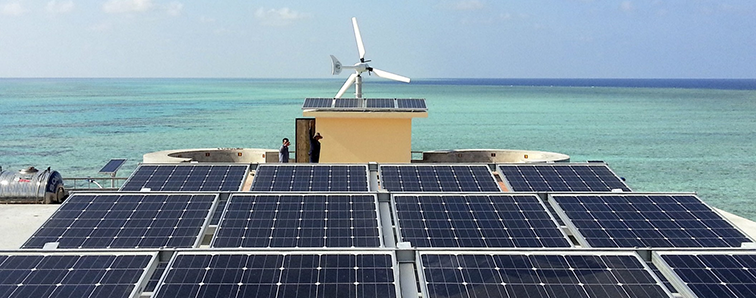

21/12/2017
In addition to electricity source such as thermal power, hydro power… the development of solar power plays an important role in contributing to the national electricity system and promoting the development of energy types and reducing greenhouse gas emission and protecting the environment.
 |
|
Solar energy system in Spratly Islands |
Potential and challenges
According to the study of the Energy Institute (Ministry of Industry and Trade) Việt Nam has huge potential for solar energy development, with an average radiation volume of 4.3 - 5.7 million kWh/m². Provinces in the North (from Thua Thien - Hue up north), on average, have about 1,800 - 2,100 sunny hours. Provinces in the South (from Da Nang down south) on average have about 2,000 - 2,600 sunny hours; the solar radiation is 20% higher than that in northern provinces. In this region, the sun shines almost throughout the year, even in rainy season, this is a favourable condition for the development of solar energy.
However, in reality, the exploitation of solar energy is not equivalent to its potential, almost all solar energy projects in Việt Nam are small-scale, mostly apply for households and service centres.
On 25/11/2015, the Prime Minister has promulgated Decision 2068/QD-TTg approving the development of renewable solar energy to 2030, vision to 2050, which clearly orientates the development of solar energy, from now to 2050, and emphasises the development of solar energy to provide electricity for the national electricity system and the border, island, remote and mountainous regions that have not been yet supplied from the national electricity grid. At the same time, to increase the rate of electricity manufactured from the solar power in the total electricity volume from insignificant level to about 0.5% in 2020, 6% in 2030 and 20% in 2050. The Electricity Planning VII (revised) that was approved by the Prime Minister also requires to enhance the progress of solar energy projects, including focal source installed on the land surface and separate source installed on the roof, increasing the capacity of solar energy to about 850 MW in 2020, 4,000 MW in 2025 and 12,000 MW in 2030. According to the plan, from now to 2020, each year, Việt Nam needs to construct solar energy plants with the capacity of 200 MW; from 2020 - 2025, each year needs to install more 600 MW and the next five continuous years, need to install 1,600 MW in order to achieve the targets.
Currently, there are about 30 solar energy projects that are being implemented by domestic and international enterprises, mostly in Central provinces such as: Quang Nam, Quang Ngai, Binh Dinh, Khanh Hoa, Ninh Thuan, Binh Thuan and the Mekong Delta. Of which, there are remarkable projects of Thien Tan Investment and Construction Company (in Quang Ngai, Ninh Thuan) and Tuy Phong project of DooSung Vina Limited Company (Korea) in Binh Thuan. In addition, the Electricity of Vietnam (EVN) also has a plan to implement two solar energy projects in Dong Nai and Binh Thuan.
However, the biggest challenge for the solar energy development is the substantial cost in investment in solar energy exploitation and usage because all manufacturing technologies and equipment need to import from overseas (mostly from China). Almost all solar energy projects use grants or foreign loans. In addition, solar energy plants are usually installed in locations that are far away from electricity transmission centres, which cause difficulties in connecting to the national electricity grid, at the same time increases connection expenses.
Enhancing the development of solar energy
In August 2016, at a regular government meeting on mechanisms to promote solar energy projects, the Prime Minister agreed with the proposal of the Ministry of Industry and Trade on promulgation of mechanisms to support the development of solar energy projects in Việt Nam. At the same time, the Prime Minister requested the Ministry of Industry and Trade to regulate in more details on the solar energy planning (development of projects based on solar radiation map, inclusion of electricity projects using solar energy into the electricity development planning…); to update the cost of solar energy equipment in order to develop appropriate electricity buying and selling prices; to study and issue regulations on procurement of solar energy projects in a transparent and open manner.
To develop solar energy projects, the Government should regulate an appropriate price of solar energy, to be harmonious with the interest of investments and to meet the objectives of green electricity development. In addition, it is necessary to study and issue regulations on the purchase of Certified Emission Reductions for solar energy projects; promulgate mechanisms to promote the development of solar energy equipment production, mechanism for connection to the national grid for enterprises and households that manufacture and use solar energy; develop standard criteria for equipment and quality tests, productivity of import products, domestic business; enhance propaganda and enhance awareness for local people on the efficient use of solar energy…
In other words, the completion of mechanisms and policies promoting the development of solar energy is very necessary, in order to create investments in solar energy, contribute to implement green growth and sustainable development in Việt Nam.
Nguyễn Thanh Giang
General Department of Energy - Ministry of Industry and Trade